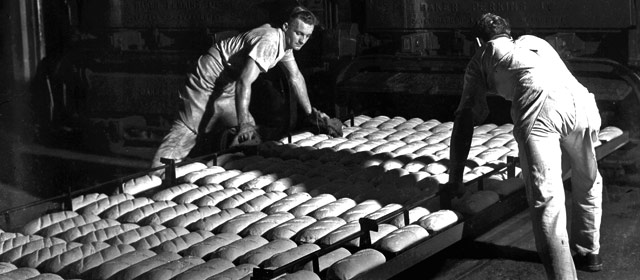Story summary
New Zealand commercial food and beverage production began in the 1860s. To begin with companies were small and often family-run businesses. Canning and the introduction of refrigerators changed how people preserved their food, and brought many new products.
Biscuits and sweets
People began selling biscuits and sweets in the 19th century. Griffin’s and Hudson’s were well known brands. England’s Cadbury chocolate company joined with Hudson’s and made chocolates, biscuits and sweets in Dunedin. Adams Bruce used eggs from their own poultry farm to make cakes for sale.
Ice cream
At first ice cream was made with ice from the mountains. When fridges arrived ice cream became very popular. The Tip Top ice cream company began in 1935 and is now part of the giant dairy company Fonterra. New Zealanders eat more ice cream than most people in the world, but they also export ice cream.
Canned food
In 1891 there were 15 canning factories in New Zealand selling food locally and overseas. St George and K brands were popular canned-goods makers. But the best-known local cannery became Wattie’s, which started in 1934, preserving all kinds of vegetables and fruit, as well as spaghetti and baked beans. In the early 2000s it was owned by global corporate Heinz.
Breakfast cereals and spreads
From 1923 New Zealand-made Marmite competed with Australian-made Vegemite as a spread for breads. Both products are savoury yeast extracts.
Milled, pre-cooked oats were sold as a one-minute porridge, Creamoata, from 1920. Its popularity fell as puffed rice, cornflakes and Weet-Bix became popular breakfast cereals. Weet-Bix was made by health food company Sanitarium. Later in the 20th century muesli became popular. In the early 2000s Hubbards was a successful cereal maker.
Bread
In the early 1900s poor people could only afford wholemeal flour, and people preferred white bread to brown wholemeal loaves. When machinery made bread-making easier, and it was faster to transport goods, bakeries grew from small to large operations.
The first sliced bread was available in the 1950s. By the 2000s plastic-wrapped sliced loaves were sold alongside freshly baked whole loaves in supermarkets. Small specialist bakeries were also popular.
Cold drinks
At first fizzy drinks were sold in bottles that could be returned to the manufacturer to be used again, for a small reward. Soft drink sales began in the 1830s and they were always popular. At first they were made by local companies, but increasingly imported brands like Coca-Cola dominated the market.
One local drink was very popular, Lemon and Paeroa, or L & P. It is now made artificially by Coca-Cola Amatil, but from 1907 to 1980 it was made from sparkling waters from the town of Paeroa.
Fruit juices and energy drinks became increasingly popular in the late-20th century.
Tea and coffee
New Zealanders were keen tea drinkers, but coffee also became popular after the Second World War. In the 1990s an urban coffee culture took off and cafés and kiosks selling freshly brewed coffee became common.





